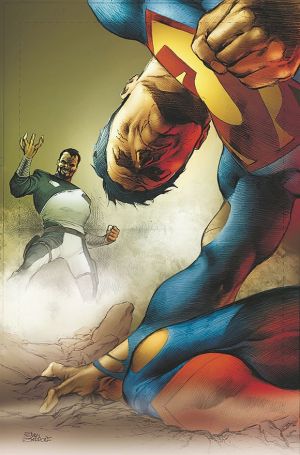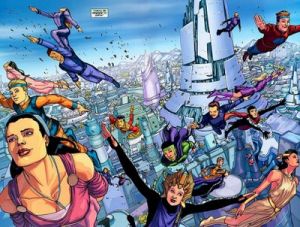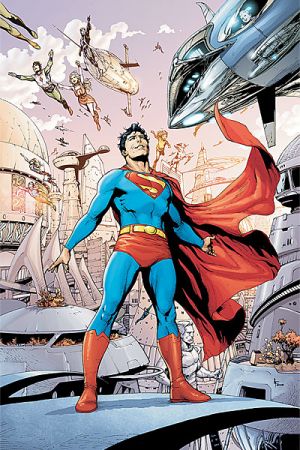New Krypton: The End (War of the Supermen #4 of 4)
By Andy Frisk
May 27, 2010 - 22:33
DC Comics
Writer(s): James Robinson and Sterling Gates
Penciller(s): Eddy Barrows, CAFU, Eduardo Pensica
Inker(s): JD Mayer and BIT
Colourist(s): Blond
Letterer(s): John J. Hill
Cover Artist(s): Eddy Barrows, JD Mayer, Rod Reis
$3.99 US
A twelve issue miniseries, several superior guest stars, the return of the triangles ( a numbering system not seen since The Death and Return of Superman), and major changes in the lives of the Superman Family’s supporting cast and a fist fight between Superman and General Zod along with a return trip to The Phantom Zone is how it all ends. All the build up, potential, and wonderful character development and introductions are for naught. Everything is reset back to square one. One word sums up the finale and outcome of Superman: War of the Supermen and the overarching New Krypton storyline, disappointing.
 |
The final issue and miniseries definitely weren’t bad by any means. The action and artwork, as well as the few storytelling twists at the end did deliver a few surprises, but the simple fact that so many of the engaging and dynamic characters that were introduced over the course of the entire New Krypton storyline are now either dead or returned to the limbo they came from is incredibly disappointing. The last major Superman storyline that can compare to New Krypton, the aforementioned Death and Return of Superman, fundamentally changed Superman’s supporting cast, namely by introducing characters that have stuck around, and played major roles in the DC Universe ever since. Superboy/Connor Kent, Steel/John Henry Irons, and The Cyborg Superman/Hank Henshaw have had a major impact on Superman’s world, and allowed for a breath of fresh air to envelop what was becoming a very stagnant character and storyline. With New Krypton, Superman’s world and cast expanded greatly again. The well written and developed characters of Mon-El, Nightwing and Flamebird, Alura, and the frightening General Lane, all of which were dynamic and engaging, are now out of the picture. Would it have been so difficult to at least keep a few around to add some depth to the storytelling world of the World’s Greatest Superhero? Obviously, 100,000 Kryptonians could not be allowed to forever exist and roam free in the DCU, and the deaths of some characters (one in particular) will have a major affect on the development of one of Superman’s main supporting characters, who’s developed into a major character in her own right, but think of the possibilities a Mon-El or Nightwing would have brought to the Superman mythos as regular (or even irregular) appearing characters, or as a part of the DCU as a whole. DC Comics really missed the boat here by dumping these great characters.
 |
While “hundreds” of Zod’s soldiers eventually were re-imprisoned in The Phantom Zone (conveniently left available for future attacks, etc.), the characters that Superman’s readers began to get attached to and wished to see more of are now simply gone. New Krypton’s overall theme, aptly summed up by Lois Lane in Superman WOTS #4 as, “Someday I hope humankind will be more receptive to change, to living as a ‘melting pot’ of people and cultures. To set aside suspicions and live together peacefully,” was powerfully and eloquently elaborated upon throughout this sprawling and multifaceted tale, but it seems DC Comics itself sort of missed the point of their own story by doing away with the new melting pot of diverse and standout characters they introduced along the way. Again, I’m not suggesting that 100,000 Kryptonians flying around is necessary, or that their continued use as a storytelling vehicle would even work logically as a part of Superman’s world or the DCU at large for that matter, but the core three of Mon-El, Nightwing, and Flamebird should have been kept around.
 |
New Krypton overall will still go down in history as one of, if not THE, greatest Superman stories of all time. Its intrigues, themes, ideas, and spirit were incredibly noble, thought provoking, and relevant. Rarely do we see this type of quality storytelling in a mainstream superhero’s titles that didn’t resort to the pitfalls of sensationalism (graphic gore, scantily clad female superheroes, and excessive violence) that plague so many mainstream heroes and their books. We were treated to powerful storytelling and compelling new characters. It’s a shame a few of them couldn’t have stuck around.
Related Articles:
Superman 2025 Movie Review
DC Classic Multiverse Superman and Page Puncher Superman Review
Le langage kryptonien de Superman dans le film Man of Steel : une analyse de la théorie des médiums
Retro Review: Superman (1988)
That Time Canada Claimed Superman for Stamps Collectors
First Appearance Superman Action Figure (2004)
So Superman Is Bisexual?
Review: Superman: Up in the Sky #2
Review: Superman’s Pal, Jimmy Olsen #1
Review: Superman #13
